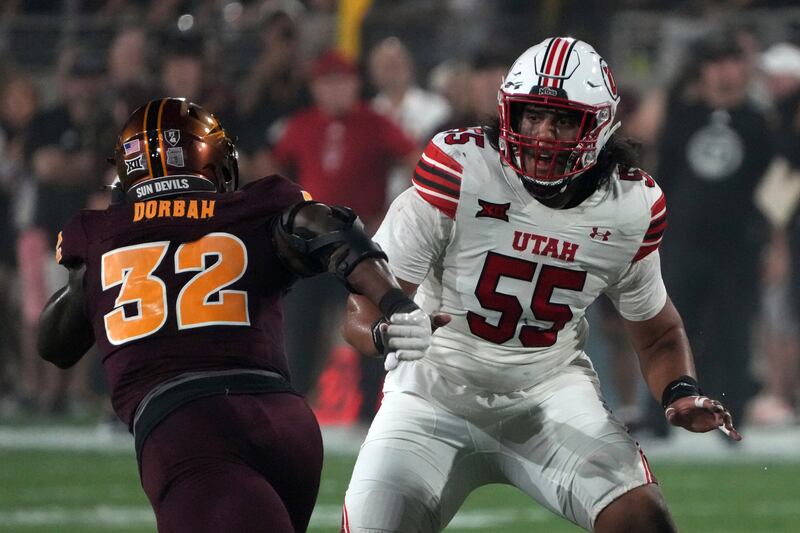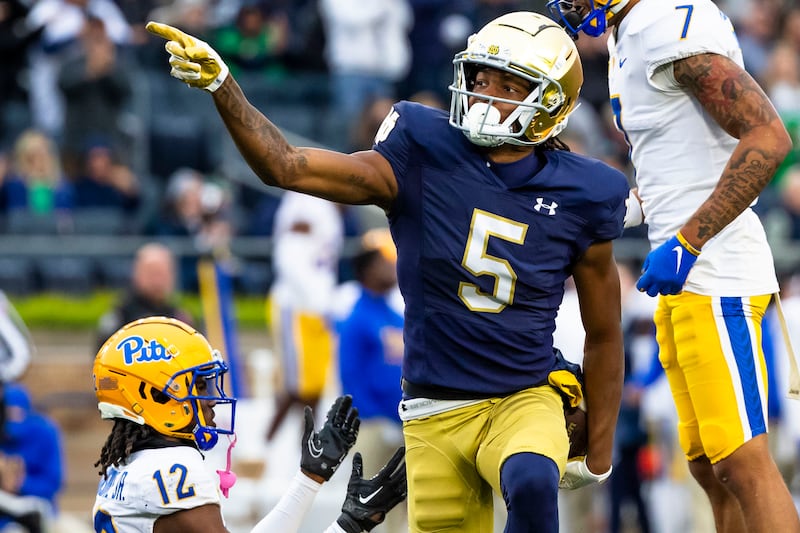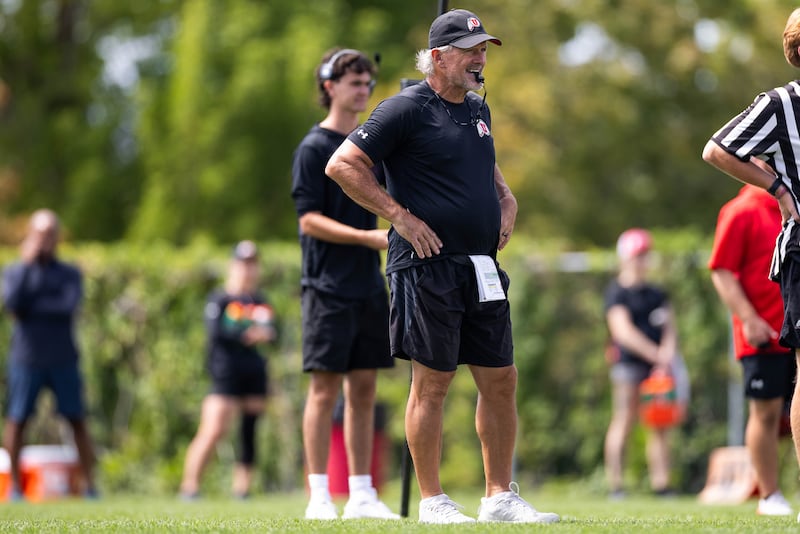This article was first published in the Ute Insiders newsletter. Sign up to receive the newsletter in your inbox each Wednesday night.
Until Monday, I had assumed that we’d see Utah’s first depth chart of the season Aug. 25 ahead of Kyle Whittingham’s weekly press conference as the Utes prepare for their first game against UCLA.
But Whittingham threw a curveball, announcing this Monday that due to the Big 12’s new mandatory injury report, Utah likely wouldn’t be releasing a depth chart this season.
Utah rarely updated the depth chart during the season — only in the event of a season-ending injury — but it did give a good snapshot of what the two-deep was ahead of the opening game.
In the absence of an official depth chart from Utah, here’s my best guess at what the offensive two-deep will look like when the Utes line up at the Rose Bowl on Aug. 30.
An article projecting the defensive two-deep will be released on Friday.
Quarterback
New Mexico transfer Devon Dampier has been the starter from the instant he transferred, and a lot of Utah’s hopes and dreams this season are resting on him.
His previous experience with Lobos offensive coordinator Jason Beck is paramount, and the duo had a lot of success last season, teaming up to power the nation’s No. 4 offense.
We’ll see how Dampier’s game translates to Big 12 play, but his success in the Mountain West — 2,768 yards and 12 TDs through the air and 1,166 yards and 19 TDs on the ground — has coaches excited for what Utah’s offense could be this year.
Utah has seen Dampier make progress in cutting down his turnovers (12 interceptions last year) and boosting his completion percentage (57.9%).
“He has. Through fall, we track everything every day with all that, and he’s done a really nice job with that and so we just want that to continue forward through the season,” Beck said.
If he can improve in those two areas while keeping similar output from last year, Utah’s offense could be a night-and-day difference from last year’s drudge.
Behind Dampier is the same QB2 from last season — Isaac Wilson.
Last year, thrown into the fire in his freshman year after Cam Rising’s injuries, Wilson struggled — 1,510 yards and 10 touchdowns with 11 interceptions on 56.4% accuracy.
He beat out freshman Byrd Ficklin in a tight QB2 battle this season, and coaches have seen strides in his game, especially in his decision-making and processing of the game.
“Just took a big step forward from where he feels the spring and just his ability to manage everything because of the experiences he’s gone through has just kind of put him a step ahead for handling the whole offense and being able to do everything he needed to,” Beck said.
Running back
Wayshawn Parker, the sophomore Washington State transfer, was considered the runaway favorite for the starting job, but New Mexico senior NaQuari Rogers has turned the situation into more of a 1a, 1b scenario.
We still expect Parker (735 yards and four touchdowns on 137 carries during his freshman season) to get most of the carries, but Rogers (382 yards and five touchdowns on 74 carries) stepped up during fall camp and closed strong to secure RB2 duties and some significant playing time.

Behind Utah’s offensive line and in Beck’s offense, Utah’s running backs should pick up right where Micah Bernard left off with a 1,000-yard season.
“They both do an outstanding job of picking up blitzes, they’re not afraid, they stick their nose in there,” Whittingham said. “They’re north and south guys, so they run behind their pads well, get upfield. They both have good hands, so they’re very similar. NaQuari just has more experience; Wayshawn’s just a sophomore.”
Rounding out the rotation could be Daniel Bray and Raycine Guillory, two freshmen that have stood out this fall.
Offensive line
Not much more needs to be said about Utah’s starting front five of Spencer Fano, Michael Mokofisi, Jaren Kump, Tanoa Togiai and Caleb Lomu.
All five returning starters are experienced and talented, and Fano and Lomu are being projected by mock draft experts to go as high as the first round in next year’s NFL draft. They’re also widely respected by their teammates — four of the starters were named to the Utes’ 12-person leadership council.
The offensive line is expected to be the strength of the offense, and has a lot of expectations placed upon it, but it’s something they welcome.

“I can say with confidence, we should be the best offensive line since I’ve been at the University of Utah, which has been forever,” Whittingham said.
While there will ultimately be some dropoff if one of the starters is injured, Beck has liked what he’s seen from the second unit.
“Right now you feel like we have three guys that can come in and play and we won’t have to drastically change too much,” Beck said. “They’ve done a nice job just kind of establishing themselves and what they can do and then we’re just looking for another guy or two to continue to make that next jump where we feel the same way about them.”
Wide receiver
Wide receiver was the biggest question mark on offense, and potentially the entire team, entering fall camp.
While they’ll have to prove it on the field, Utah coaches are optimistic about this group and the progress they made over fall camp.
Leading the way is Cal transfer Tobias Merriweather, who caught 11 passes for 125 yards and a score while playing in just five games last year due to injury. Those numbers, by the way, would have placed him No. 3 among Utah’s receivers in 2024. Merriweather began his college career at Notre Dame.

“You got a kid in Tobias who’s 6-5, 200 pounds, runs a 4.4 (40-yard dash),” receivers coach Micah Simon said. “So prototypical type of guy you like.”
Southern Miss transfer Larry Simmons, a post-spring transfer like Merriweather, has also been someone coaches, and Dampier, have singled out.
“They were so new when they got here, it was just getting everything going. But they both have played and done stuff in the past where they’re, yeah, they’re comfortable stepping in and playing right off the bat,” Beck said. “So they’ve done a good job just trying to get them up to speed as fast as possible. And yeah, they’re both doing a nice job coming along and will help us this year.”
In the slot, expect to see Ryan Davis and Creed Whittemore. Davis, from New Mexico, already has great chemistry with Dampier (the duo connected for 747 yards and three scores) and knows Beck’s offense.
Whittemore, from Mississippi State, is another option that Utah coaches feel like they can count on.
Don’t forget about Daidren Zipperer, who is the only returning Ute wide receiver with significant stats (eight catches for 122 yards) and has made strides this offseason.
“The most consistent is (Ryan Davis). He maybe had a leg up coming from New Mexico with being consistent and having chemistry with that,” Beck said.
“But then all the other guys have just been the new guys, Larry, Tobias, Zip’s been in that deal, Justin’s been in there. So a lot of those guys have just been improving, getting better, and we’re just focusing in as we’re starting to set that game plan on what can they do to help us win.”
Tight end
Traditionally a position of strength in recent years for the Utes, the tight end room enters the 2025 season without a proven player at the position.
It remains to be seen just how much Beck will use the tight ends — it will likely be less than Ludwig did — but they will still be an important piece of the offense.
Dallen Bentley, who didn’t have the breakout year some thought he would last season (two receptions for 15 yards), is slated to be the Utes’ top tight end, with Hunter Andrews, the running-back-turned-tight-end, expected to play a big role as well.
Freshman JJ Buchanan has also impressed in fall camp and should see the field in 2025.
“It’s been one of our more consistent rooms with that mix of guys showing up every day and that includes JJ, he came in as a young kid and he’s done a really nice job as he’s been in there and improving each week,” Beck said. “So they’ve been a strength of the group in terms of their consistency and what they’re getting done.”
Utah’s projected 2025 offensive depth chart
Starter; backup
- QB: Devon Dampier (Jr.); Isaac Wilson (So.)
- RB: Wayshawn Parker (So.); NaQuari Rogers (Sr.)
- RT: Spencer Fano (Jr.); Zereoue Williams (R-Sr.)
- RG: Michael Mokofisi (R-Sr); Keith Olsen (R-Jr.)
- C: Jaren Kump (R-Sr.); Alex Harrison (R-Sr.)
- LG: Tanoa Togiai (R-Sr.); Isaiah Garcia (R-Fr.)
- LT: Caleb Lomu (R-So.); Solatoa Moea’i (Jr.)
- WR: Larry Simmons (Jr.); Daidren Zipperer (R-So.)
- WR: Tobias Merriweather (Jr.); Justin Stevenson (R-So.)
- WR: Ryan Davis (R-Sr.); Creed Whittemore (R-So.)
- TE: Dallen Bentley (Sr.); Hunter Andrews (R-Fr.)
In case you missed it
Isaac Wilson was named Utah’s backup quarterback. Here’s what went into the decision.
From the archives
Extra points
Utah gymnastics’ scheduling philosophy may soon have to change in a major way
Not to worry BYU and Utah fans, Cougars and Utes are in good company
It doesn’t look like revenue sharing will lead to more transparency regarding player compensation


